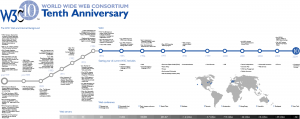In 1989, Tim Berners-Lee invented the World Wide Web (see the original proposal). He coined the term « World Wide Web, » wrote the first World Wide Web server, « httpd, » and the first client program (a browser and editor), « WorldWideWeb, » in October 1990. He wrote the first version of the « HyperText Markup Language » (HTML), the document formatting language with the capability for hypertext links that became the primary publishing format for the Web. His initial specifications for URIs, HTTP, and HTML were refined and discussed in larger circles as Web technology spread.
In October 1994, Tim Berners-Lee founded the World Wide Web Consortium (W3C) at the Massachusetts Institute of Technology, Laboratory for Computer Science [MIT/LCS] in collaboration with CERN, where the Web originated (see information on the original CERN Server), with support from DARPA and the European Commission. In April 1995, INRIA (Institut National de Recherche en Informatique et Automatique) became the first European W3C host, followed by Keio University of Japan (Shonan Fujisawa Campus) in Asia in 1996. In 2003, ERCIM (European Research Consortium in Informatics and Mathematics) took over the role of European W3C Host from INRIA. In 2013, W3C announcedBeihang University as the fourth Host.





